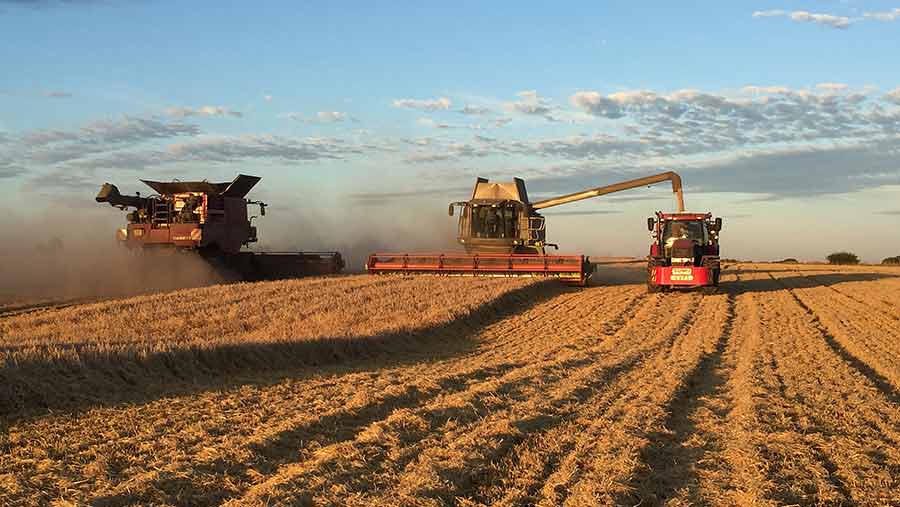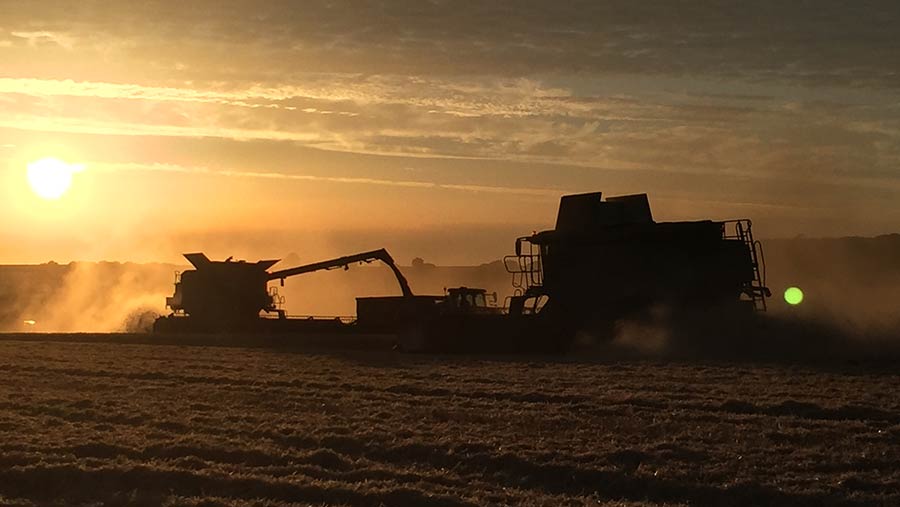Harvest 2016: Blackgrass blamed for ergot in wheat
Ergot problems due to blackgrass and poor bean quality concerns are emerging this week, as many farmers in Scotland are still harvesting wheat.
Harvest in the Borders and across Scotland has been very variable, according to Bruce Ferguson, managing director at Aberdeen Grain.

© Peter Lamb
See also: Harvest slump triggers cashflow warning
Across the board, yields match about the five-year average at best, while quality is extremely inconsistent.
“Spring barley has varied depending on the area; it has been very good in the Borders, with low nitrogen, skinnings and reasonable screenings.
“However, in central Scotland and Aberdeenshire, it has been more variable, while in Morayshire quality is better again,” explains Mr Ferguson.
“Second wheats in the Borders have not yielded so well, but the first wheats have done better, albeit no higher than the five-year average.
“Further north the quality looks okay, but it is too early to tell what the yields will be like.”
Oats
Winter oats have so far been of good quality and yielded reasonably well.
“There have been no problems with the oats; all have been more than 50kg/hl and farmers are just getting into the wheats,” says Mr Ferguson.
The quality of oat crops this harvest has been pretty similar to last year, while yields have reportedly been lower, according to Shaun Jenkins, grain manager at European Oat Millers.
“There have been no issues with colour or skin finish, but quality is definitely poorer than last year. Hullability has not been as good and there will definitely be higher losses this year,” he says.
Some specific weights have been low, ranging from 48kg/hl to 54kg/hl, with screenings at 3-5%, although kernel contents have been a bit lower than last year.
Ergot and blackgrass
In Lincolnshire, harvest has been much smaller than last year, according to Dan Murphy, laboratory and haulage manager at Woldgrain.
“We have seen a lot of cereal and grass ergot, which we think is related to blackgrass, as it has been significantly worse than in previous years,” he says.
“Aside from the ergot, quality has generally been alright, with protein in wheats up to 15%.”
The majority of Group 1s came in at about 13% protein or higher, while hagbergs have been good.
“They [hagbergs] have ranged from 200 on Group 3 soft wheats to 400-plus for the Group 1 milling varieties.”
Specific weights have been average, with most between 74kg/hl to 76kg/hl, he adds.
High nitrogens
Spring barley has been generally good, with very little pre-germination of malting barley, but a few samples of Propino had high nitrogen levels, so might struggle to find a domestic market, says Mr Murphy.
“The majority are from 1.65-1.85%.” Specific weights have averaged 65-67kg/hl.
Mr Murphy has also seen a couple of samples of beans that look good, with nice colour and size, but as crops have not started to arrive in bulk, he is uncertain of yields.

© Peter Lamb
Poor peas
According to Guy Palmer, trader at Dalmark grain in Cambridgeshire, peas for human consumption have been terrible this harvest.
“Yields have been dramatically down and some crops have almost failed,” he says.
Winter beans have been okay so far, but will mostly go for feed as they are stained and broken due to being combined while very dry.
“The majority of spring beans, though small, will go for human consumption, as they have good colour.”
Wheats are good on the whole, with nice quality and high proteins. “Group 1s off good land, where we would normally expect 13% protein, have achieved 15%,” says Mr Palmer.
Yields are about average, while hagbergs have been fine. Specific weights in feed wheat have been 72-74kg/hl and milling wheats achieved 76-78kg/hl. Spring wheats have suffered badly from ergot, but otherwise have been good on the whole.
Shropshire
Across in Shropshire, Duncan Whiteman has finished combining at Arlescott Farm, Telford. Though his winter barley was disappointing, his oilseed rape came off well at 3.5t/ha and his Mascani oats yielded 8-8.2t/ha with a specific weight of 53kg/hl.
“Skyfall was relatively disappointing, with specific weights around 68kg/hl, while the Reflection was excellent. It had some issues with yellow rust but that did not seem to affect it at all,” he says.
“Everything came in dry which was a real contrast to last year.”

